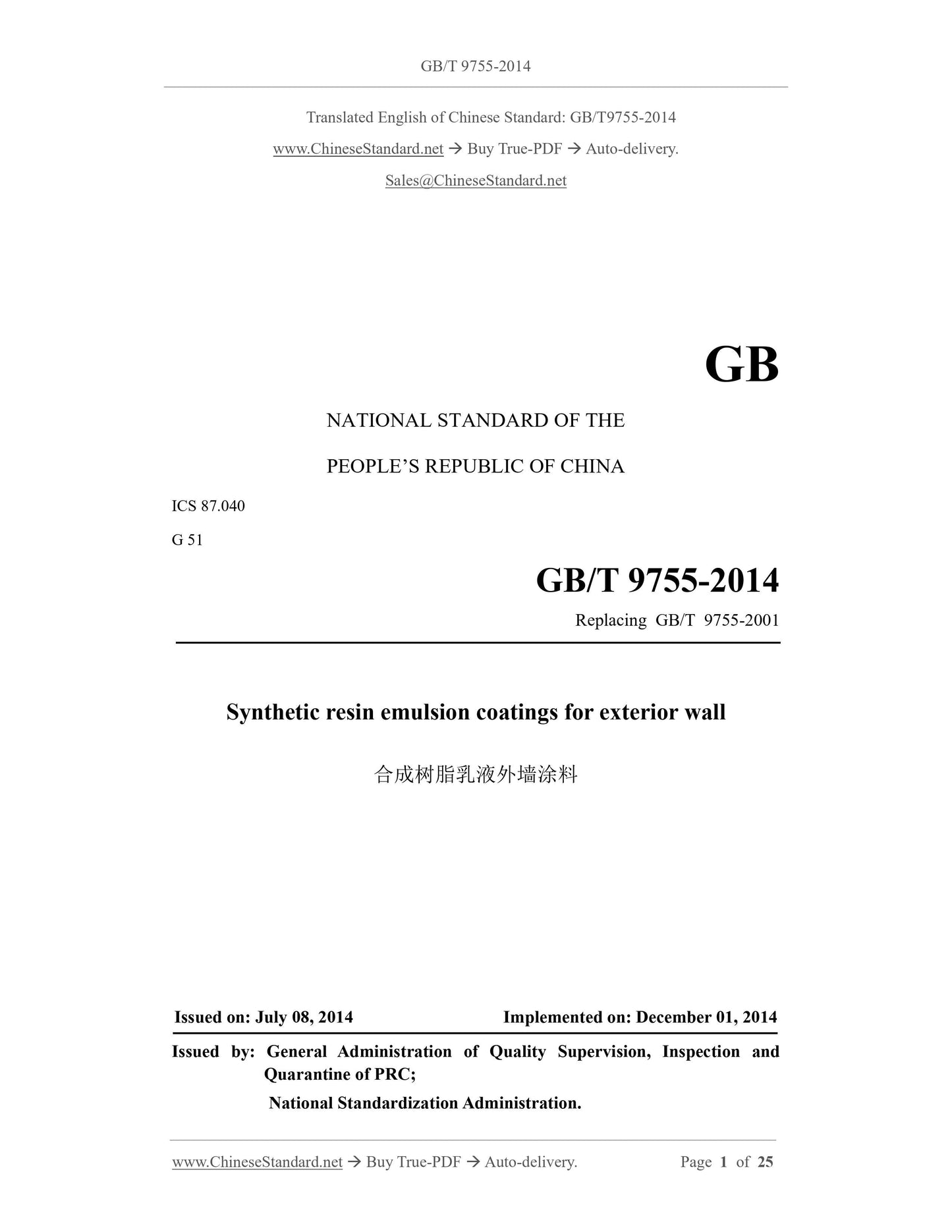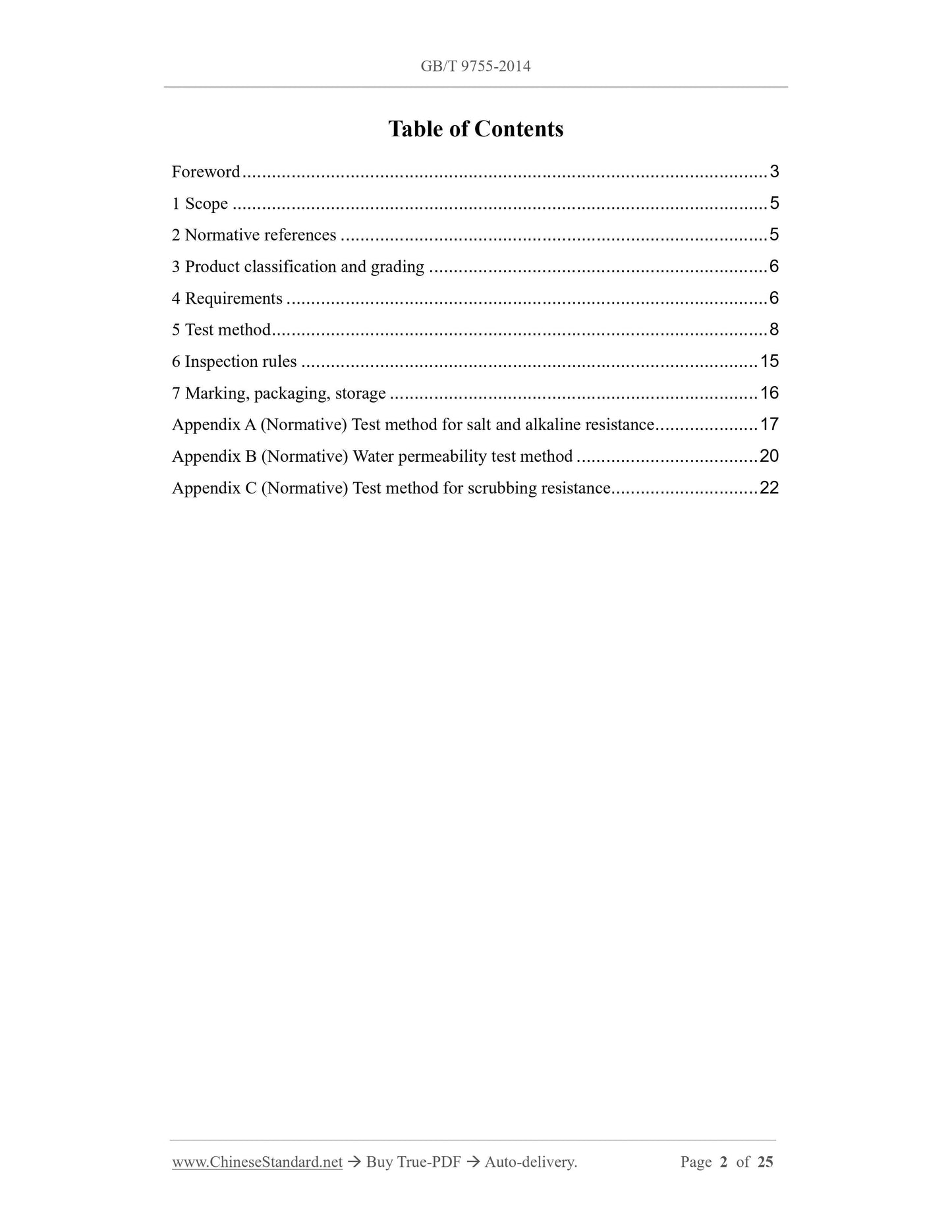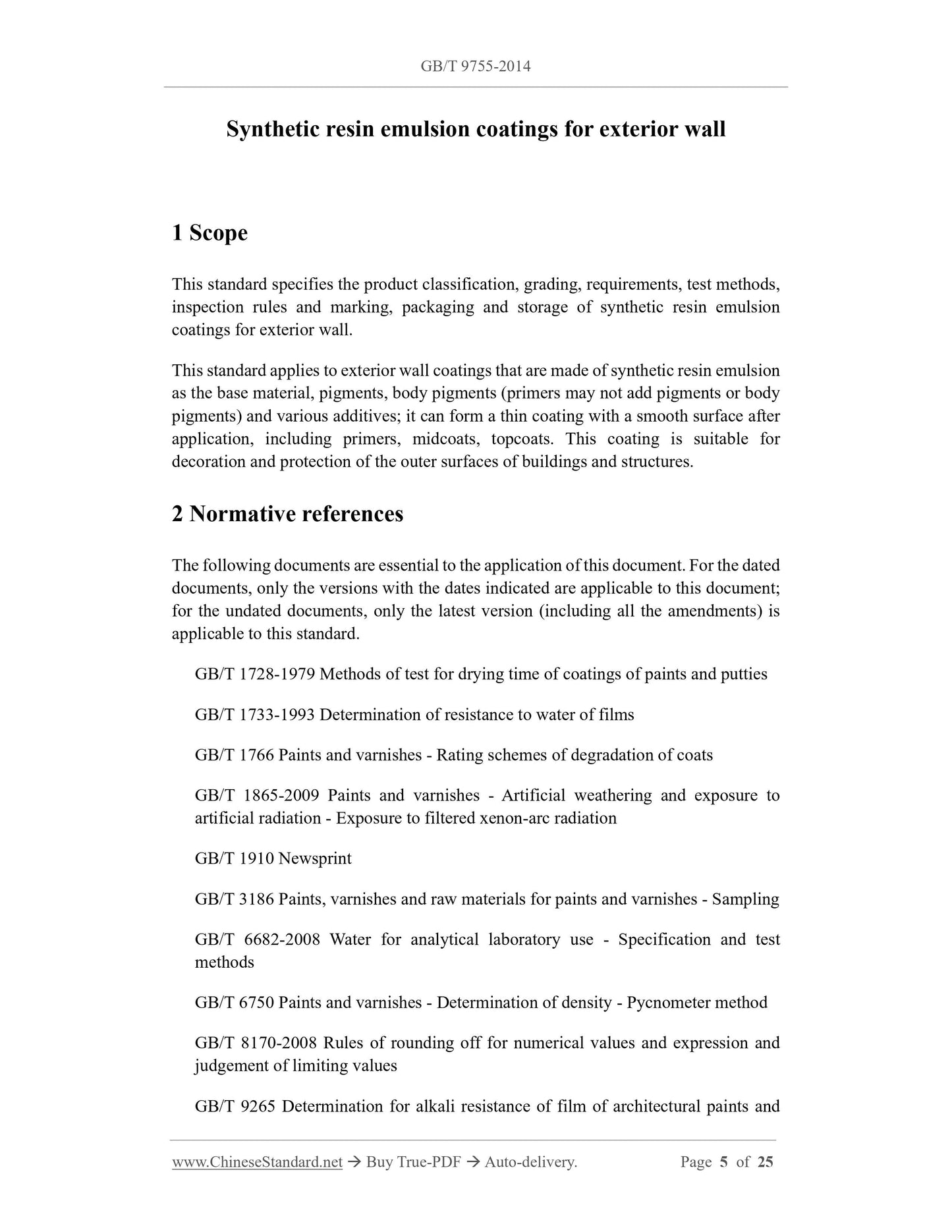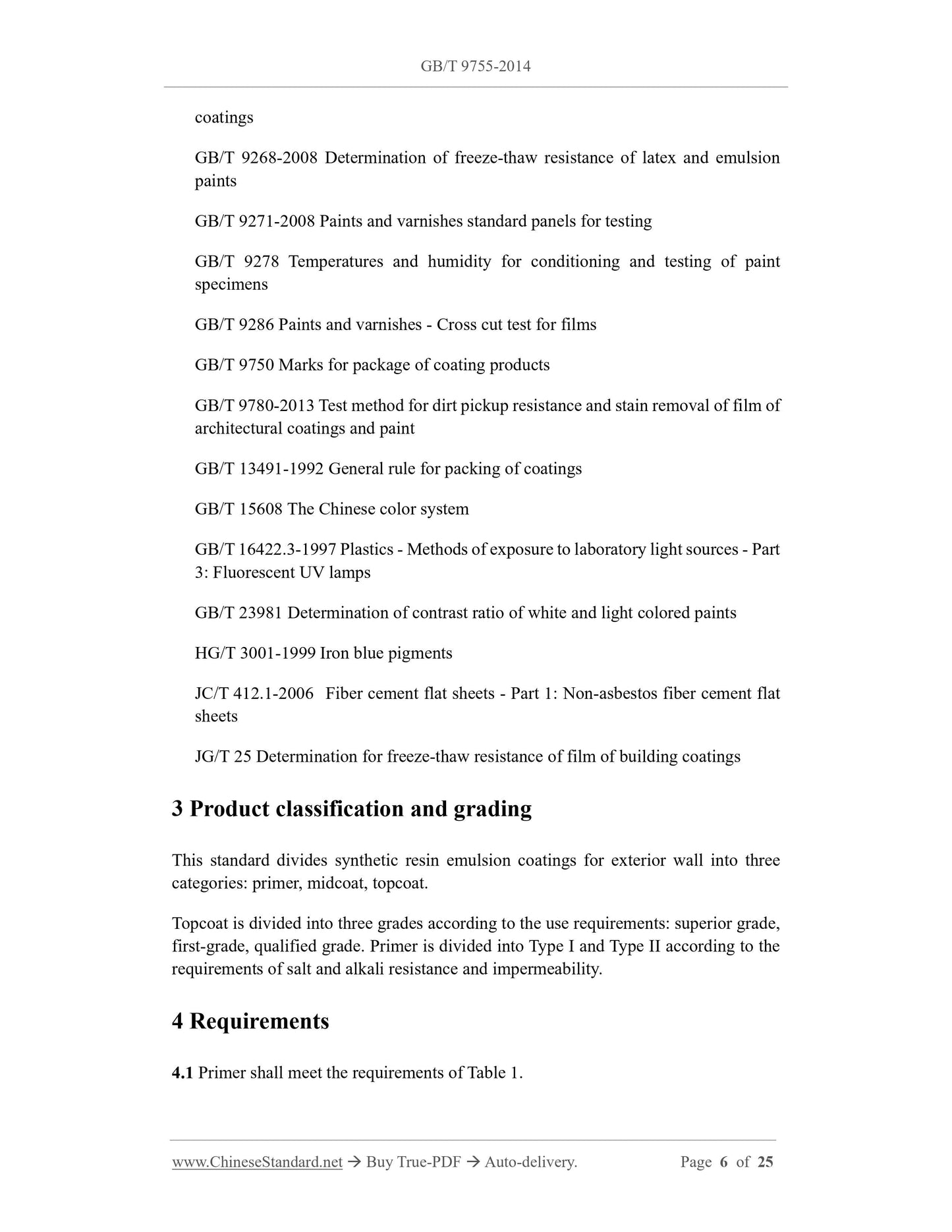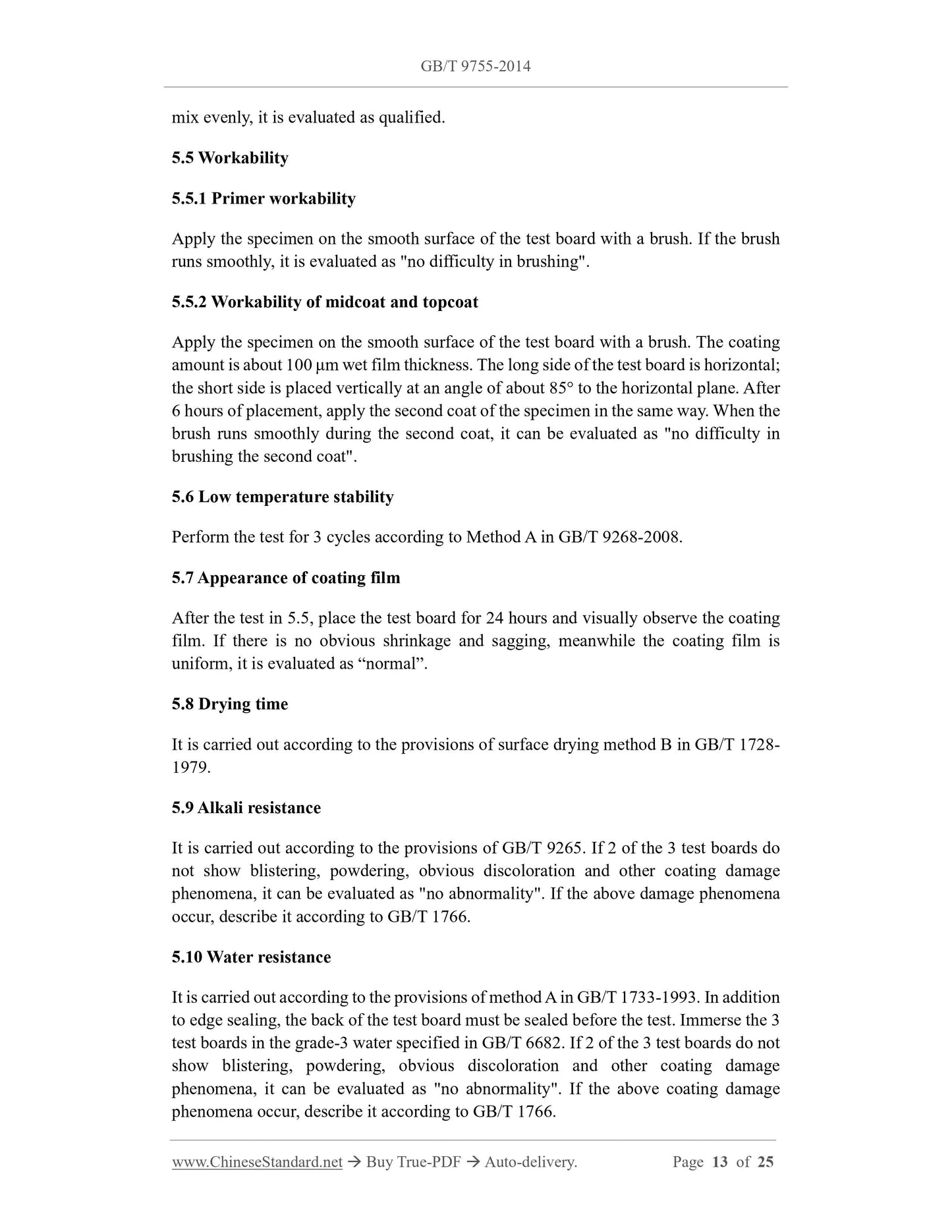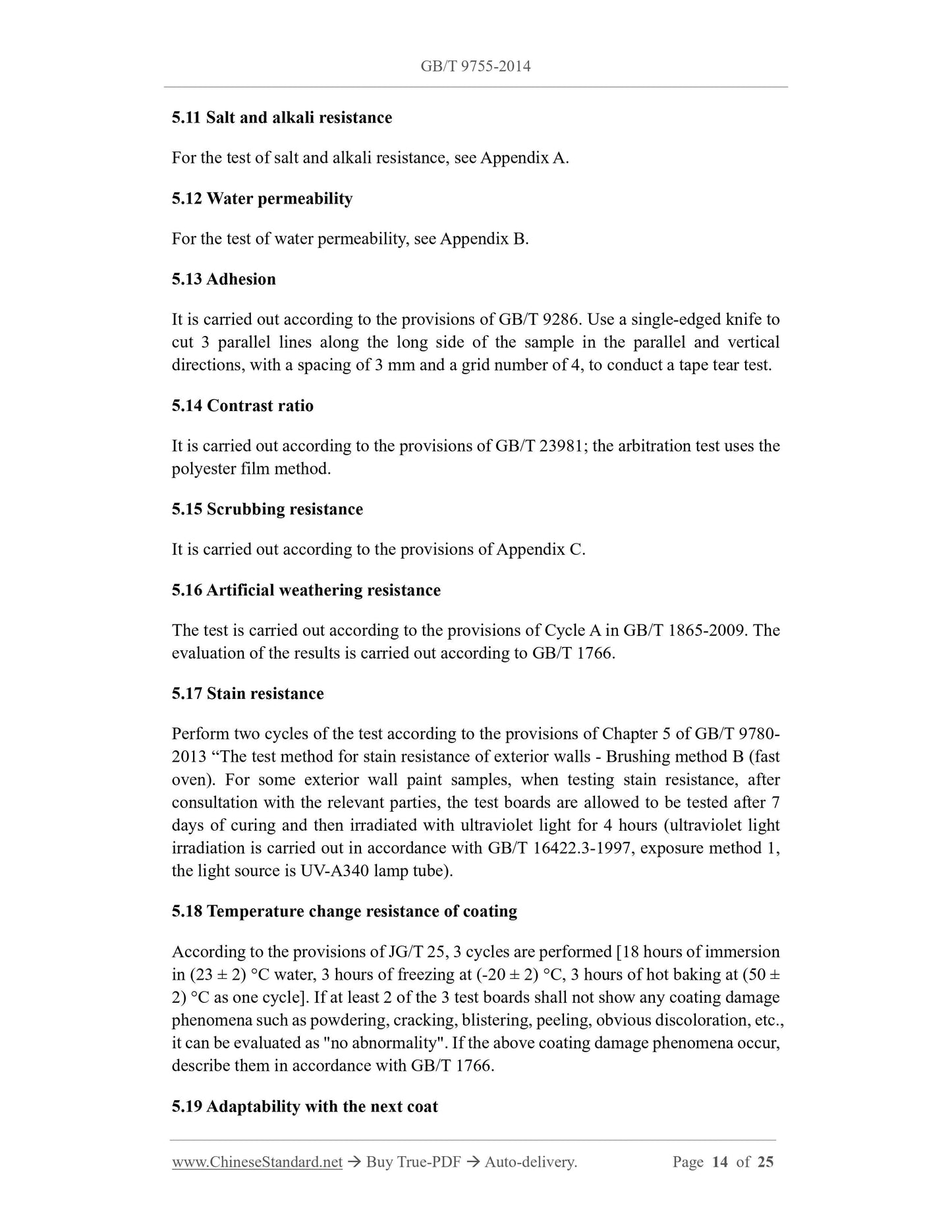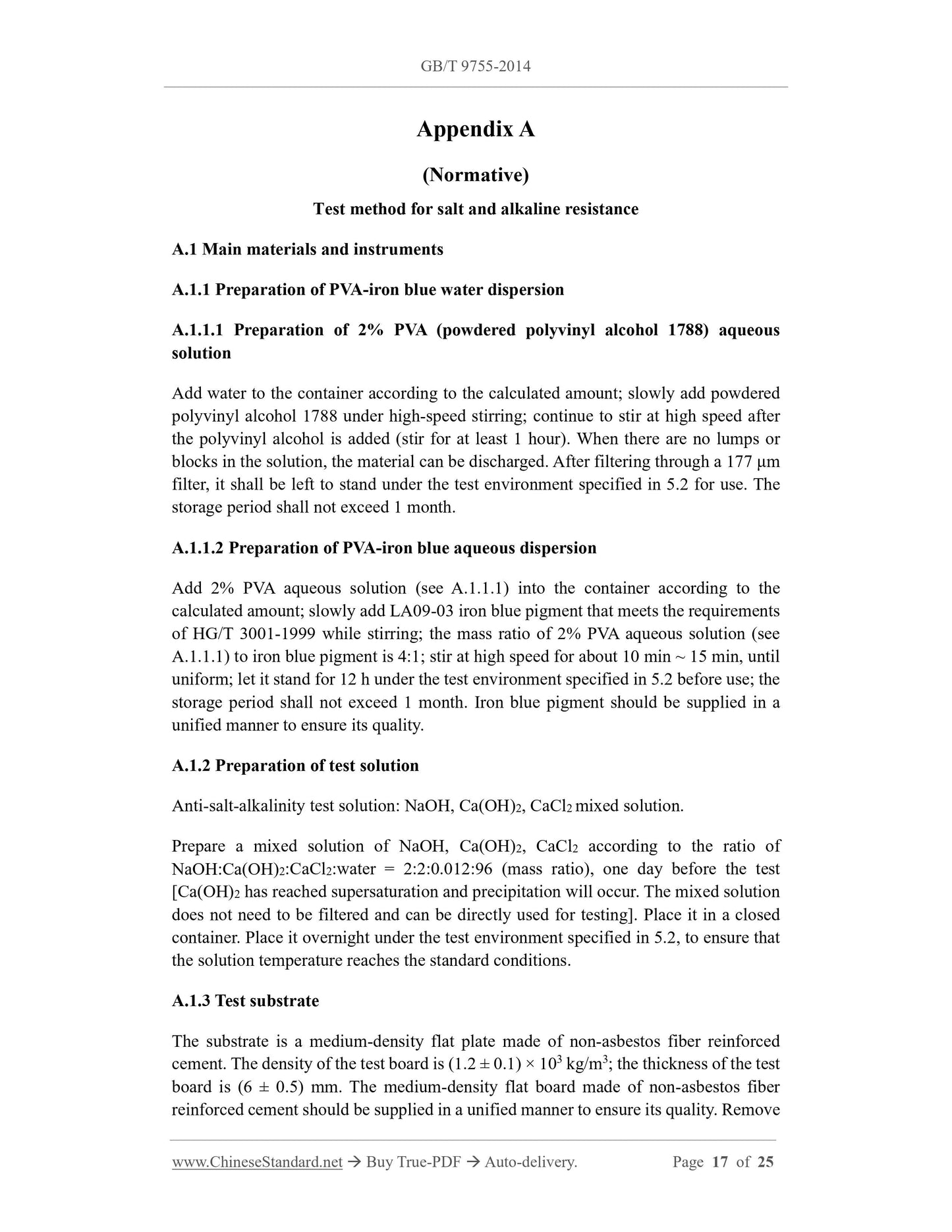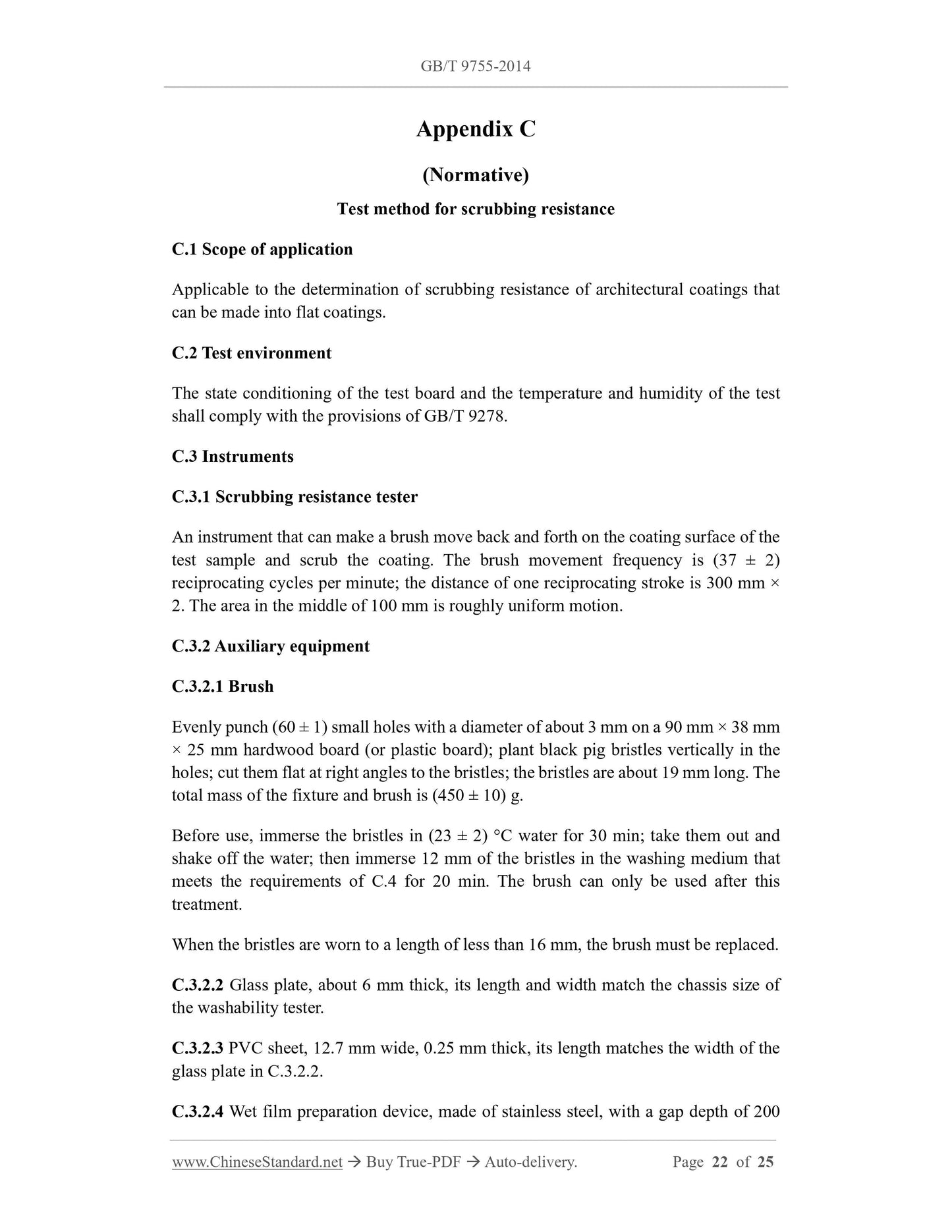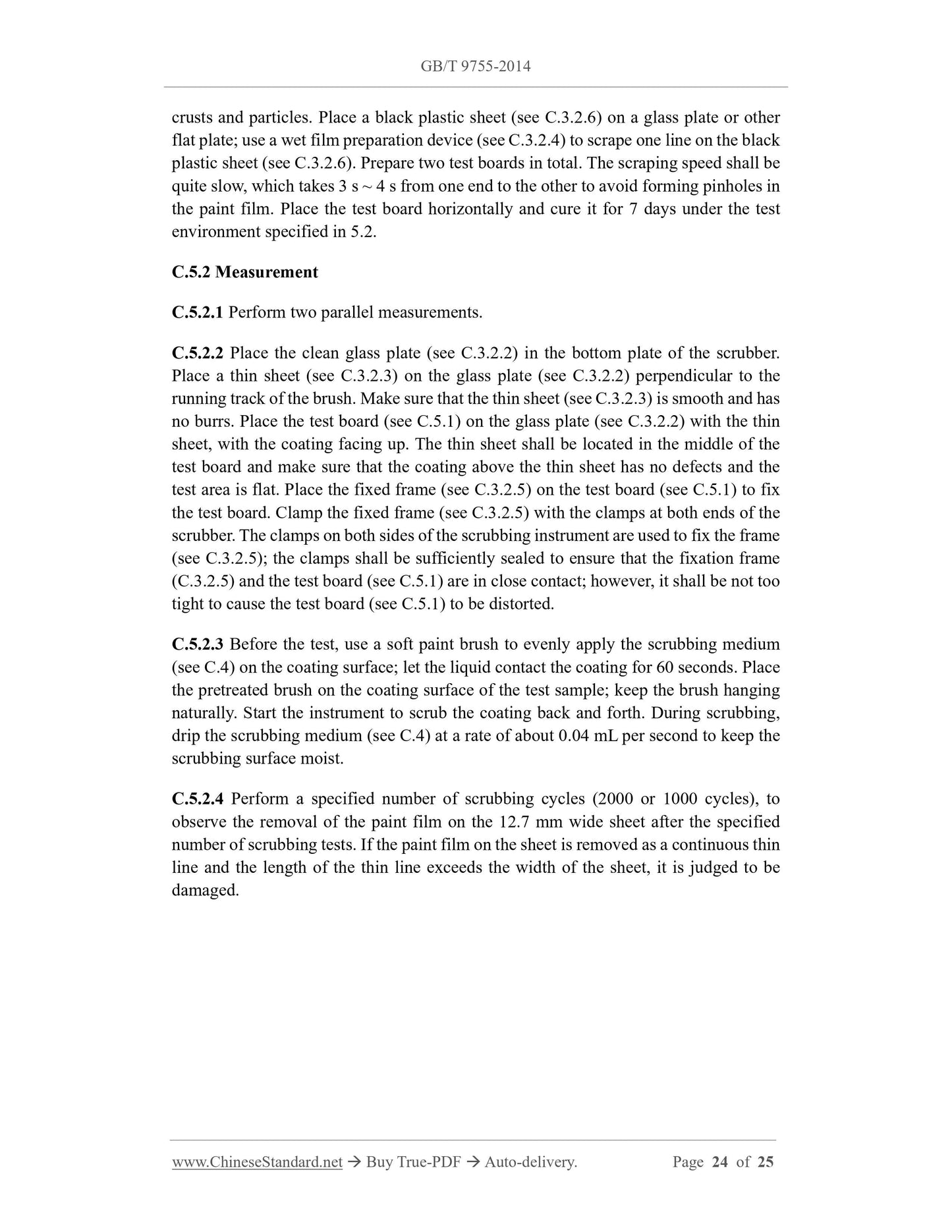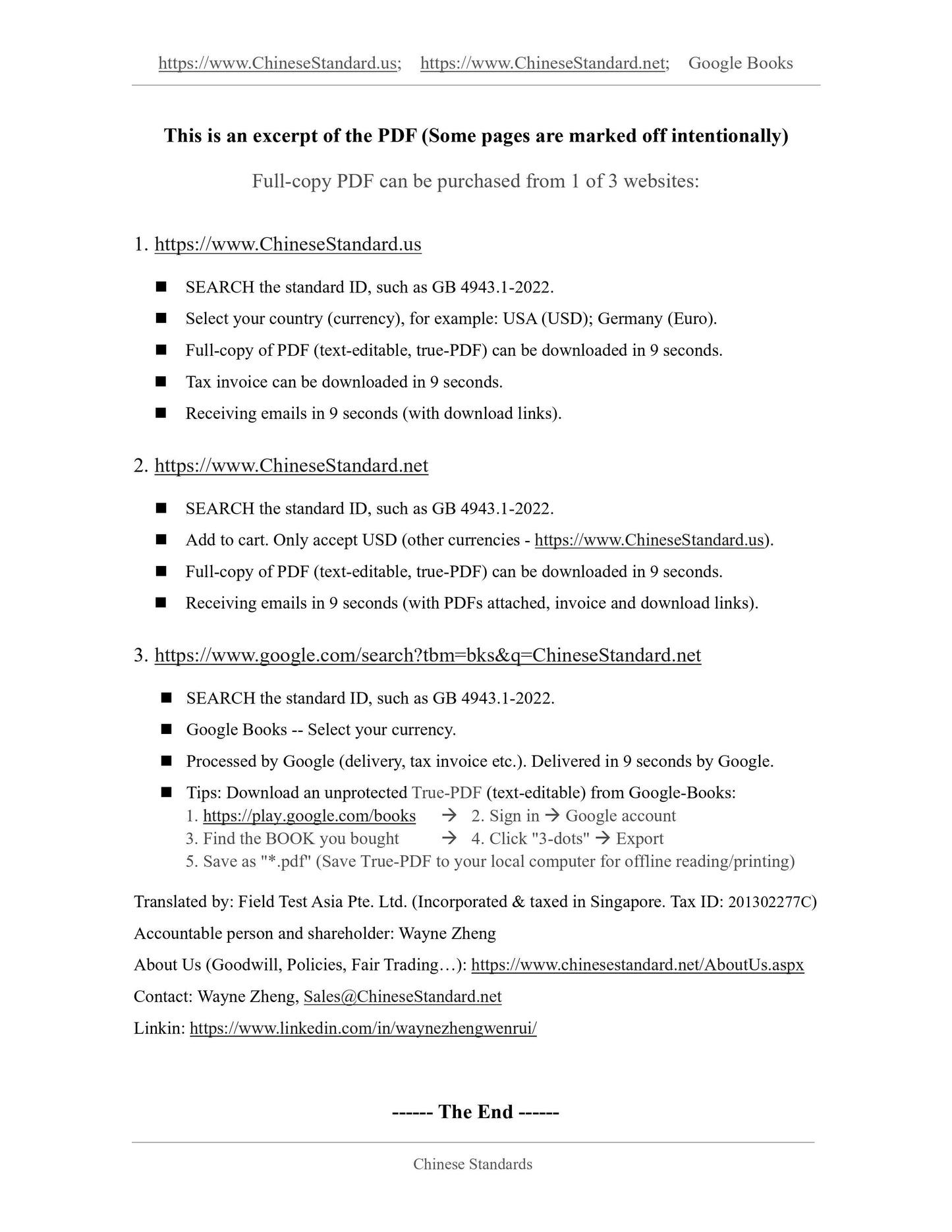1
/
의
10
PayPal, credit cards. Download editable-PDF and invoice in 1 second!
GB/T 9755-2014 English PDF (GBT9755-2014)
GB/T 9755-2014 English PDF (GBT9755-2014)
정가
$305.00 USD
정가
할인가
$305.00 USD
단가
/
단위
배송료는 결제 시 계산됩니다.
픽업 사용 가능 여부를 로드할 수 없습니다.
Delivery: 3 seconds. Download true-PDF + Invoice.
Get QUOTATION in 1-minute: Click GB/T 9755-2014
Historical versions: GB/T 9755-2014
Preview True-PDF (Reload/Scroll if blank)
GB/T 9755-2014: Synthetic resin emulsion coatings for exterior wall
GB/T 9755-2014
GB
NATIONAL STANDARD OF THE
PEOPLE’S REPUBLIC OF CHINA
ICS 87.040
G 51
Replacing GB/T 9755-2001
Synthetic resin emulsion coatings for exterior wall
合成树脂乳液外墙涂料
ISSUED ON. JULY 08, 2014
IMPLEMENTED ON. DECEMBER 01, 2014
Issued by. General Administration of Quality Supervision, Inspection and
Quarantine of PRC;
National Standardization Administration.
Table of Contents
Foreword... 3
1 Scope... 5
2 Normative references... 5
3 Product classification and grading... 6
4 Requirements... 6
5 Test method... 8
6 Inspection rules... 15
7 Marking, packaging, storage... 16
Appendix A (Normative) Test method for salt and alkaline resistance... 17
Appendix B (Normative) Water permeability test method... 20
Appendix C (Normative) Test method for scrubbing resistance... 22
Synthetic resin emulsion coatings for exterior wall
1 Scope
This standard specifies the product classification, grading, requirements, test methods,
inspection rules and marking, packaging and storage of synthetic resin emulsion
coatings for exterior wall.
This standard applies to exterior wall coatings that are made of synthetic resin emulsion
as the base material, pigments, body pigments (primers may not add pigments or body
pigments) and various additives; it can form a thin coating with a smooth surface after
application, including primers, midcoats, topcoats. This coating is suitable for
decoration and protection of the outer surfaces of buildings and structures.
2 Normative references
The following documents are essential to the application of this document. For the dated
documents, only the versions with the dates indicated are applicable to this document;
for the undated documents, only the latest version (including all the amendments) is
applicable to this standard.
GB/T 1728-1979 Methods of test for drying time of coatings of paints and putties
GB/T 1733-1993 Determination of resistance to water of films
GB/T 1766 Paints and varnishes - Rating schemes of degradation of coats
GB/T 1865-2009 Paints and varnishes - Artificial weathering and exposure to
artificial radiation - Exposure to filtered xenon-arc radiation
GB/T 1910 Newsprint
GB/T 3186 Paints, varnishes and raw materials for paints and varnishes - Sampling
GB/T 6682-2008 Water for analytical laboratory use - Specification and test
methods
GB/T 6750 Paints and varnishes - Determination of density - Pycnometer method
GB/T 8170-2008 Rules of rounding off for numerical values and expression and
judgement of limiting values
GB/T 9265 Determination for alkali resistance of film of architectural paints and
coatings
GB/T 9268-2008 Determination of freeze-thaw resistance of latex and emulsion
paints
GB/T 9271-2008 Paints and varnishes standard panels for testing
GB/T 9278 Temperatures and humidity for conditioning and testing of paint
specimens
GB/T 9286 Paints and varnishes - Cross cut test for films
GB/T 9750 Marks for package of coating products
GB/T 9780-2013 Test method for dirt pickup resistance and stain removal of film of
architectural coatings and paint
GB/T 13491-1992 General rule for packing of coatings
GB/T 15608 The Chinese color system
GB/T 16422.3-1997 Plastics - Methods of exposure to laboratory light sources - Part
3.Fluorescent UV lamps
GB/T 23981 Determination of contrast ratio of white and light colored paints
HG/T 3001-1999 Iron blue pigments
JC/T 412.1-2006 Fiber cement flat sheets - Part 1.Non-asbestos fiber cement flat
sheets
JG/T 25 Determination for freeze-thaw resistance of film of building coatings
3 Product classification and grading
This standard divides synthetic resin emulsion coatings for exterior wall into three
categories. primer, midcoat, topcoat.
Topcoat is divided into three grades according to the use requirements. superior grade,
first-grade, qualified grade. Primer is divided into Type I and Type II according to the
requirements of salt and alkali resistance and impermeability.
4 Requirements
4.1 Primer shall meet the requirements of Table 1.
mix evenly, it is evaluated as qualified.
5.5 Workability
5.5.1 Primer workability
Apply the specimen on the smooth surface of the test board with a brush. If the brush
runs smoothly, it is evaluated as "no difficulty in brushing".
5.5.2 Workability of midcoat and topcoat
Apply the specimen on the smooth surface of the test board with a brush. The coating
amount is about 100 μm wet film thickness. The long side of the test board is horizontal;
the short side is placed vertically at an angle of about 85° to the horizontal plane. After
6 hours of placement, apply the second coat of the specimen in the same way. When the
brush runs smoothly during the second coat, it can be evaluated as "no difficulty in
brushing the second coat".
5.6 Low temperature stability
Perform the test for 3 cycles according to Method A in GB/T 9268-2008.
5.7 Appearance of coating film
After the test in 5.5, place the test board for 24 hours and visually observe the coating
film. If there is no obvious shrinkage and sagging, meanwhile the coating film is
uniform, it is evaluated as “normal”.
5.8 Drying time
It is carried out according to the provisions of surface drying method B in GB/T 1728-
1979.
5.9 Alkali resistance
It is carried out according to the provisions of GB/T 9265.If 2 of the 3 test boards do
not show blistering, powdering, obvious discoloration and other coating damage
phenomena, it can be evaluated as "no abnormality". If the above damage phenomena
occur, describe it according to GB/T 1766.
5.10 Water resistance
It is carried out according to the provisions of method A in GB/T 1733-1993.In addition
to edge sealing, the back of the test board must be sealed before the test. Immerse the 3
test boards in the grade-3 water specified in GB/T 6682.If 2 of the 3 test boards do not
show blistering, powdering, obvious discoloration and other coating damage
phenomena, it can be evaluated as "no abnormality". If the above coating damage
phenomena occur, describe it according to GB/T 1766.
5.11 Salt and alkali resistance
For the test of salt and alkali resistance, see Appendix A.
5.12 Water permeability
For the test of water permeability, see Appendix B.
5.13 Adhesion
It is carried out according to the provisions of GB/T 9286.Use a single-edged knife to
cut 3 parallel lines along the long side of the sample in the parallel and vertical
directions, with a spacing of 3 mm and a grid number of 4, to conduct a tape tear test.
5.14 Contrast ratio
It is carried out according to the provisions of GB/T 23981; the arbitration test uses the
polyester film method.
5.15 Scrubbing resistance
It is carried out according to the provisions of Appendix C.
5.16 Artificial weathering resistance
The test is carried out according to the provisions of Cycle A in GB/T 1865-2009.The
evaluation of the results is carried out according to GB/T 1766.
5.17 Stain resistance
Perform two cycles of the test according to the provisions of Chapter 5 of GB/T 9780-
2013 “The test method for stain resistance of exterior walls - Brushing method B (fast
oven). For some exterior wall paint samples, when testing stain resistance, after
consultation with the relevant parties, the test boards are allowed to be tested after 7
days of curing and then irradiated with ultraviolet light for 4 hours (ultraviolet light
irradiation is carried out in accord...
Get QUOTATION in 1-minute: Click GB/T 9755-2014
Historical versions: GB/T 9755-2014
Preview True-PDF (Reload/Scroll if blank)
GB/T 9755-2014: Synthetic resin emulsion coatings for exterior wall
GB/T 9755-2014
GB
NATIONAL STANDARD OF THE
PEOPLE’S REPUBLIC OF CHINA
ICS 87.040
G 51
Replacing GB/T 9755-2001
Synthetic resin emulsion coatings for exterior wall
合成树脂乳液外墙涂料
ISSUED ON. JULY 08, 2014
IMPLEMENTED ON. DECEMBER 01, 2014
Issued by. General Administration of Quality Supervision, Inspection and
Quarantine of PRC;
National Standardization Administration.
Table of Contents
Foreword... 3
1 Scope... 5
2 Normative references... 5
3 Product classification and grading... 6
4 Requirements... 6
5 Test method... 8
6 Inspection rules... 15
7 Marking, packaging, storage... 16
Appendix A (Normative) Test method for salt and alkaline resistance... 17
Appendix B (Normative) Water permeability test method... 20
Appendix C (Normative) Test method for scrubbing resistance... 22
Synthetic resin emulsion coatings for exterior wall
1 Scope
This standard specifies the product classification, grading, requirements, test methods,
inspection rules and marking, packaging and storage of synthetic resin emulsion
coatings for exterior wall.
This standard applies to exterior wall coatings that are made of synthetic resin emulsion
as the base material, pigments, body pigments (primers may not add pigments or body
pigments) and various additives; it can form a thin coating with a smooth surface after
application, including primers, midcoats, topcoats. This coating is suitable for
decoration and protection of the outer surfaces of buildings and structures.
2 Normative references
The following documents are essential to the application of this document. For the dated
documents, only the versions with the dates indicated are applicable to this document;
for the undated documents, only the latest version (including all the amendments) is
applicable to this standard.
GB/T 1728-1979 Methods of test for drying time of coatings of paints and putties
GB/T 1733-1993 Determination of resistance to water of films
GB/T 1766 Paints and varnishes - Rating schemes of degradation of coats
GB/T 1865-2009 Paints and varnishes - Artificial weathering and exposure to
artificial radiation - Exposure to filtered xenon-arc radiation
GB/T 1910 Newsprint
GB/T 3186 Paints, varnishes and raw materials for paints and varnishes - Sampling
GB/T 6682-2008 Water for analytical laboratory use - Specification and test
methods
GB/T 6750 Paints and varnishes - Determination of density - Pycnometer method
GB/T 8170-2008 Rules of rounding off for numerical values and expression and
judgement of limiting values
GB/T 9265 Determination for alkali resistance of film of architectural paints and
coatings
GB/T 9268-2008 Determination of freeze-thaw resistance of latex and emulsion
paints
GB/T 9271-2008 Paints and varnishes standard panels for testing
GB/T 9278 Temperatures and humidity for conditioning and testing of paint
specimens
GB/T 9286 Paints and varnishes - Cross cut test for films
GB/T 9750 Marks for package of coating products
GB/T 9780-2013 Test method for dirt pickup resistance and stain removal of film of
architectural coatings and paint
GB/T 13491-1992 General rule for packing of coatings
GB/T 15608 The Chinese color system
GB/T 16422.3-1997 Plastics - Methods of exposure to laboratory light sources - Part
3.Fluorescent UV lamps
GB/T 23981 Determination of contrast ratio of white and light colored paints
HG/T 3001-1999 Iron blue pigments
JC/T 412.1-2006 Fiber cement flat sheets - Part 1.Non-asbestos fiber cement flat
sheets
JG/T 25 Determination for freeze-thaw resistance of film of building coatings
3 Product classification and grading
This standard divides synthetic resin emulsion coatings for exterior wall into three
categories. primer, midcoat, topcoat.
Topcoat is divided into three grades according to the use requirements. superior grade,
first-grade, qualified grade. Primer is divided into Type I and Type II according to the
requirements of salt and alkali resistance and impermeability.
4 Requirements
4.1 Primer shall meet the requirements of Table 1.
mix evenly, it is evaluated as qualified.
5.5 Workability
5.5.1 Primer workability
Apply the specimen on the smooth surface of the test board with a brush. If the brush
runs smoothly, it is evaluated as "no difficulty in brushing".
5.5.2 Workability of midcoat and topcoat
Apply the specimen on the smooth surface of the test board with a brush. The coating
amount is about 100 μm wet film thickness. The long side of the test board is horizontal;
the short side is placed vertically at an angle of about 85° to the horizontal plane. After
6 hours of placement, apply the second coat of the specimen in the same way. When the
brush runs smoothly during the second coat, it can be evaluated as "no difficulty in
brushing the second coat".
5.6 Low temperature stability
Perform the test for 3 cycles according to Method A in GB/T 9268-2008.
5.7 Appearance of coating film
After the test in 5.5, place the test board for 24 hours and visually observe the coating
film. If there is no obvious shrinkage and sagging, meanwhile the coating film is
uniform, it is evaluated as “normal”.
5.8 Drying time
It is carried out according to the provisions of surface drying method B in GB/T 1728-
1979.
5.9 Alkali resistance
It is carried out according to the provisions of GB/T 9265.If 2 of the 3 test boards do
not show blistering, powdering, obvious discoloration and other coating damage
phenomena, it can be evaluated as "no abnormality". If the above damage phenomena
occur, describe it according to GB/T 1766.
5.10 Water resistance
It is carried out according to the provisions of method A in GB/T 1733-1993.In addition
to edge sealing, the back of the test board must be sealed before the test. Immerse the 3
test boards in the grade-3 water specified in GB/T 6682.If 2 of the 3 test boards do not
show blistering, powdering, obvious discoloration and other coating damage
phenomena, it can be evaluated as "no abnormality". If the above coating damage
phenomena occur, describe it according to GB/T 1766.
5.11 Salt and alkali resistance
For the test of salt and alkali resistance, see Appendix A.
5.12 Water permeability
For the test of water permeability, see Appendix B.
5.13 Adhesion
It is carried out according to the provisions of GB/T 9286.Use a single-edged knife to
cut 3 parallel lines along the long side of the sample in the parallel and vertical
directions, with a spacing of 3 mm and a grid number of 4, to conduct a tape tear test.
5.14 Contrast ratio
It is carried out according to the provisions of GB/T 23981; the arbitration test uses the
polyester film method.
5.15 Scrubbing resistance
It is carried out according to the provisions of Appendix C.
5.16 Artificial weathering resistance
The test is carried out according to the provisions of Cycle A in GB/T 1865-2009.The
evaluation of the results is carried out according to GB/T 1766.
5.17 Stain resistance
Perform two cycles of the test according to the provisions of Chapter 5 of GB/T 9780-
2013 “The test method for stain resistance of exterior walls - Brushing method B (fast
oven). For some exterior wall paint samples, when testing stain resistance, after
consultation with the relevant parties, the test boards are allowed to be tested after 7
days of curing and then irradiated with ultraviolet light for 4 hours (ultraviolet light
irradiation is carried out in accord...
Share
